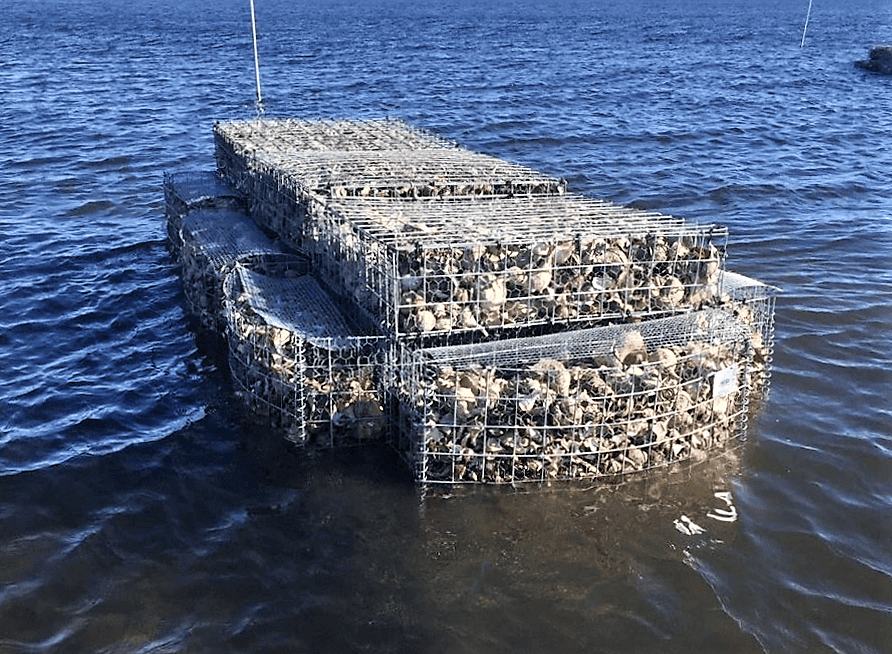by Jay Watson, Co-Executive Director, New Jersey Conservation Foundation
When you think of “mighty” animals, a few that may come to mind are lions, tigers and bears (oh my!). The oyster is probably at the bottom of the list.
But did you know that one adult oyster can clean 50 gallons of contaminated water a day? And that colonies of oysters, growing together to form a reef, can protect bayside shorelines from storm erosion and provide habitat for a multitude of other species? Oysters may not be physically imposing, but they’re mighty in their impact on the marine environment!
That’s why oyster restoration projects in Raritan Bay, Delaware Bay and Barnegat Bay are gaining in popularity. Millions and millions of oysters have been introduced in recent years by the American Littoral Society, the NY/NJ Baykeeper, and their partners.
“It’s really cool and a lot of people are getting involved,” said Tim Dillingham, executive director of the Sandy Hook-based American Littoral Society. “It amazes me how much it’s captured the public’s imagination.”
“Oysters are incredible little filters,” marvels Greg Remaud, CEO of NY/NJ Baykeeper.
To demonstrate the power of these bivalves to the public, his staff places several oysters on the bottom of a fish tank and fills it with murky water, filled with algae and sediments.
“Literally, within 15 to 20 minutes, you’ll see the water getting noticeably cleaner,” said Remaud. “I’m still astounded by this 50 years later.”
Hundreds of years ago, New Jersey’s bays were chock full of oyster beds, providing a reliable food source and livelihood for many communities. But overharvesting, pollution and disease wiped out nearly all native populations by the early 1900s.
The oyster restoration projects by the NY/NJ Baykeeper and American Littoral Society are aimed at improving water quality and coastal resiliency – but not raising oysters as food.
Because of concerns about poachers trying to harvest oysters that may be unsafe to eat, the Baykeeper encountered many early obstacles in getting permission to launch its oyster project in Raritan Bay. Luckily, it found a willing partner in Naval Weapons Station Earle in Monmouth County, which includes a huge waterfront zone in Raritan Bay.
“You don’t have stronger security anywhere,” noted Remaud.
Using baby oysters raised in tanks, the NY/NJ Baykeeper created a “living shoreline” in the bay near the Navy facility. Because oysters need something solid to cling onto, the Baykeeper builds oyster “castles” — stackable cement structures with nooks and crannies where juvenile oysters can attach.
Every year, more oyster castles are added to the reef. Together, the structures form underwater “speed bumps” to dissipate wave energy during coastal storms, thus reducing erosion and damage to the shoreline.
The Baykeeper launched its project at Naval Weapons Station Earle in 2010, but the project accelerated after Superstorm Sandy devastated huge swaths of New Jersey’s shoreline in October 2012.
“Superstorm Sandy did, in fact, create stronger interest in what oysters can do,” said Remaud.
Damage from Superstorm Sandy also led to the American Littoral Society’s projects to build oyster reefs in the Delaware Bay.
In the months after Sandy, the Littoral Society and its partners rebuilt six eroded Delaware Bay beaches to give breeding native horseshoe crabs a place to lay their eggs in the spring. This, in turn, supports the red knot, a long-distance migratory shorebird that depends on horseshoe crab eggs as a food source during its migration stopover in New Jersey.
To keep the rebuilt Delaware Bay beaches intact, the Littoral Society created oyster reefs by placing bags full of oyster larvae attached to whelk shells offshore.
The 200-foot-long oyster reefs are “intertidal,” meaning that they’re exposed during low tide and covered during high tide. The blocks of shell bags are arranged in a herringbone pattern to minimize the possibility of trapping horseshoe crabs or other aquatic creatures as the tide goes out.
Dillingham said the new oyster reefs attract a diversity of marine life, including crabs, sponges, and many fish species. “We’re asking our oysters to do a lot – filtering water, providing habitat for other species and protecting the shoreline,” he said.
In an effort to improve poor water quality in Barnegat Bay, which is affected by contaminants washed into the water by rain, the Littoral Society is experimenting with “subtidal” oyster reefs. These reefs, which remain submerged throughout the tide cycle, have been built at Forked River Beach and at Good Luck Point.
“Not only are the oysters filtering water and taking nutrients out, they’re also providing structure” on the bay floor, said Dillingham.
Oyster reefs are also being created at the mouth of the Maurice River, which flows into the Delaware Bay.
To continue to build reefs, the Littoral Society has launched a “Shuck It, Don’t Chuck It” program to collect oyster shells from fish markets, restaurants and consumers. Sixteen restaurants and markets save their discarded oysters shells for future reef construction, and community oyster shell drop-offs have been established in Point Pleasant and Rumson.
It is amazing to see the incredible natural resource benefits and shoreline protection provided by what some might perceive as tiny, ignoble organisms. It is also amazing that this state we’re in has so many talented natural resource nonprofits and professionals working in our landscape.
To learn more about oyster reefs and how they help the environment, visit the American Littoral Society website at www.littoralsociety.org/oyster-reefs.html and the NY/NJ Baykeeper website at www.nynjbaykeeper.org/coastal-restoration-program-update-july-21 2022.
And for information about preserving New Jersey’s land and natural resources, visit the New Jersey Conservation Foundation website at www.njconservation.org or contact me at [email protected].

